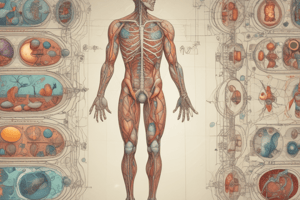Podcast
Questions and Answers
What is homeostasis?
What is homeostasis?
- The ability of the body to maintain a relatively constant internal environment despite external changes (correct)
- The ability of the body toadjust its internal environment to match the external environment
- The ability of the body to respond quickly to external stimuli
- The ability of the body to change its internal environment in response to external changes
What is the goal of homeostasis?
What is the goal of homeostasis?
- To maintain equilibrium around a set point (correct)
- To adjust the internal environment to match the external environment
- To respond quickly to external stimuli
- To maintain a constant internal environment
What is the term for a change in the internal or external environment that is detected by a receptor?
What is the term for a change in the internal or external environment that is detected by a receptor?
- Homeostasis
- Equilibrium
- Response
- Stimulus (correct)
What is the role of the nervous system in maintaining homeostasis?
What is the role of the nervous system in maintaining homeostasis?
What is the role of the endocrine system in maintaining homeostasis?
What is the role of the endocrine system in maintaining homeostasis?
What is the structure that connects the nervous and endocrine systems?
What is the structure that connects the nervous and endocrine systems?
What is the term for a mechanism that restores homeostasis?
What is the term for a mechanism that restores homeostasis?
What type of feedback loop occurs when a response to a stimulus reverses the direction of the stimulus?
What type of feedback loop occurs when a response to a stimulus reverses the direction of the stimulus?
What is the main function of the receptor in homeostatic regulation?
What is the main function of the receptor in homeostatic regulation?
What is the normal range of internal body temperature in a healthy individual?
What is the normal range of internal body temperature in a healthy individual?
What is the primary function of the circulatory system?
What is the primary function of the circulatory system?
What is the main difference between negative and positive feedback mechanisms?
What is the main difference between negative and positive feedback mechanisms?
What is the primary function of the skeletal system?
What is the primary function of the skeletal system?
Which tissue type is responsible for detecting internal and external stimuli?
Which tissue type is responsible for detecting internal and external stimuli?
What is the primary function of the endocrine system?
What is the primary function of the endocrine system?
What is the primary function of the integumentary system?
What is the primary function of the integumentary system?
Flashcards are hidden until you start studying
Study Notes
Homeostasis
- Maintains relatively constant conditions in the internal environment despite changes in the external environment
- Also known as dynamic equilibrium
- Goal is to maintain equilibrium around a set point, with normal fluctuations
Receptors and Response
- A change in the internal or external environment is called a stimulus, detected by a receptor
- Response is to adjust the deviation parameter towards the set point
Nervous and Endocrine Systems
- Two systems that maintain homeostasis
- Nervous system responds quickly to stimuli using action potentials and neurotransmitters
- Endocrine system responds to stimulation by secreting hormones into the circulatory system
- Responses to endocrine system stimulation are typically slow or long-lasting
Hypothalamus
- Brain structure that connects the Nervous and Endocrine Systems
- Controls an astonishing amount of behavior
Feedback Loops
- Mechanisms that restore homeostasis
- Positive feedback loop: original stimulus is intensified or reinforced
- Negative feedback loop: response opposes the initial change and drives the variable back towards the set point
Homeostatic Regulation
- Has three parts: receptor, control center, and effector
- Receptor: sensor sensitive to a particular environmental change or stimulus
- Control center: receives and processes information supplied by the receptor
- Effector: cell or organ that responds to the commands of the control center
Thermal Regulation
- Process that allows the body to maintain its core internal temperature
- Mechanisms designed to return the body to homeostasis
- Healthy internal body temperature: 98-100°F
- Extremes of body temperature can affect the body's ability to function
Body Systems
- Circulatory: transports oxygen, nutrients, and wastes, helps regulate body temperature
- Digestive: breaks down and absorbs nutrients, eliminates waste
- Endocrine: influences growth, development, and metabolism, maintains homeostasis
- Excretory: eliminates waste products, helps maintain homeostasis
- Immune: protects against disease, stores and generates white blood cells
- Integumentary: acts as a barrier, helps regulate body temperature
- Muscular: produces voluntary and involuntary movement, helps circulate blood and move food through digestive system
- Nervous: regulates body's response to changes in internal and external environment, processes information
- Reproductive: produces reproductive cells, provides environment for embryo
- Respiratory: brings oxygen for cells, expels CO2 and water vapor
- Skeletal: supports and protects vital organs, allows movement, stores minerals
Tissue Types
- Epithelial: covers the body, lines body cavities, forms glands
- Connective: provides protection, support, immunity, and energy storage
- Muscle: allows for body movement, heat generation, and movement of material within the body
- Nerve: detects internal and external stimuli, allowing the body to respond via electrical impulses
Studying That Suits You
Use AI to generate personalized quizzes and flashcards to suit your learning preferences.




